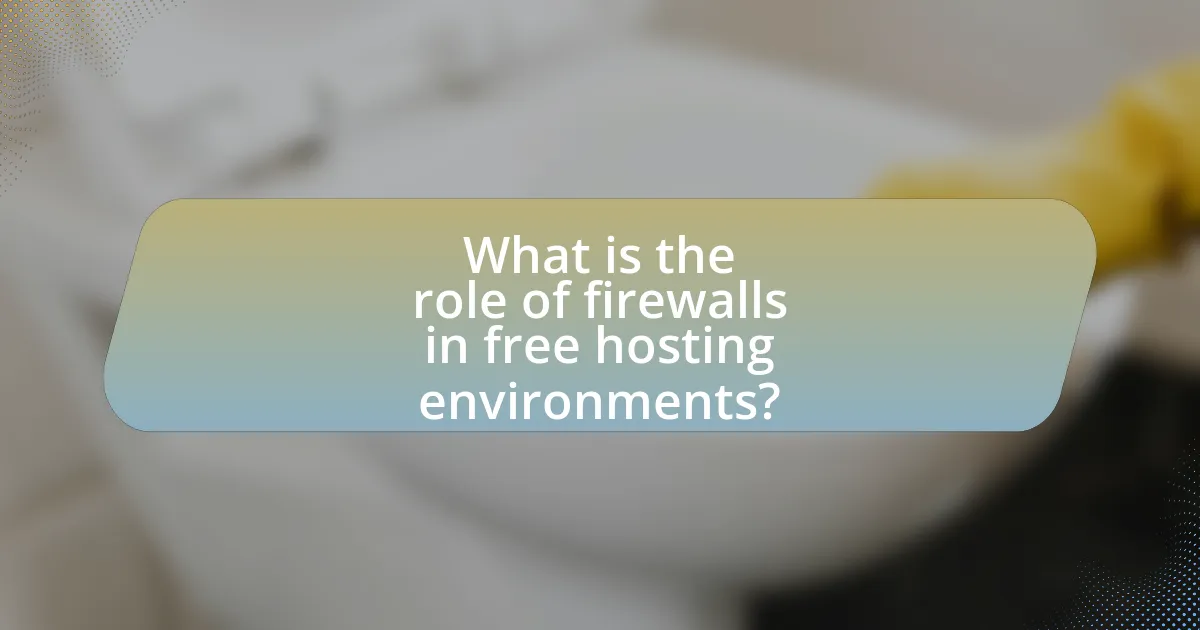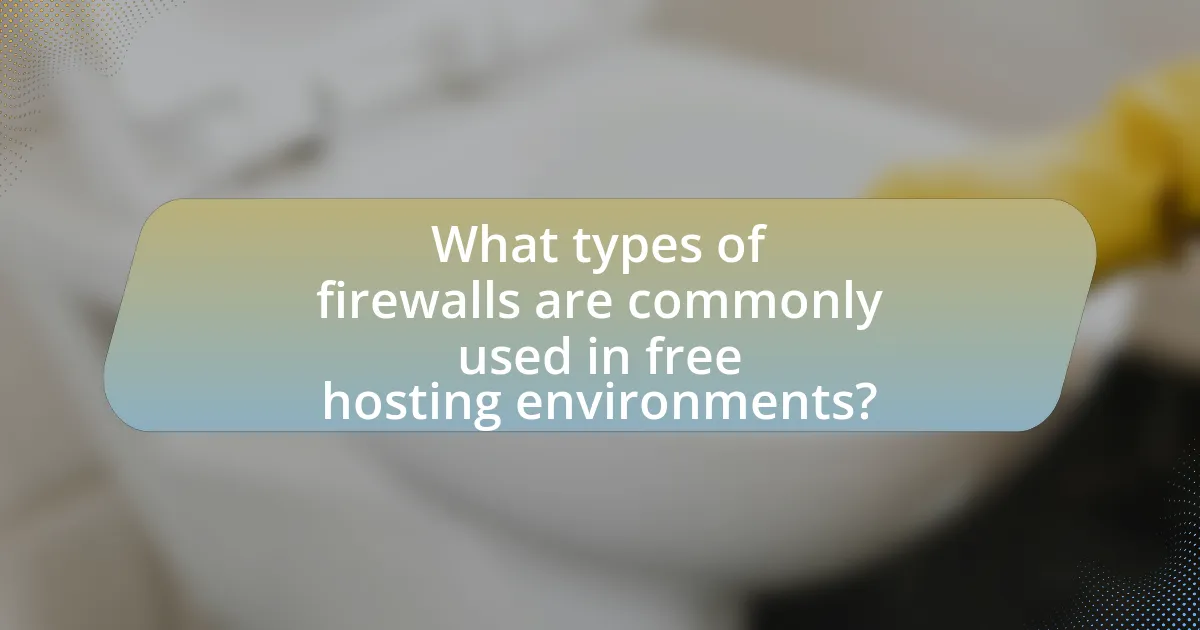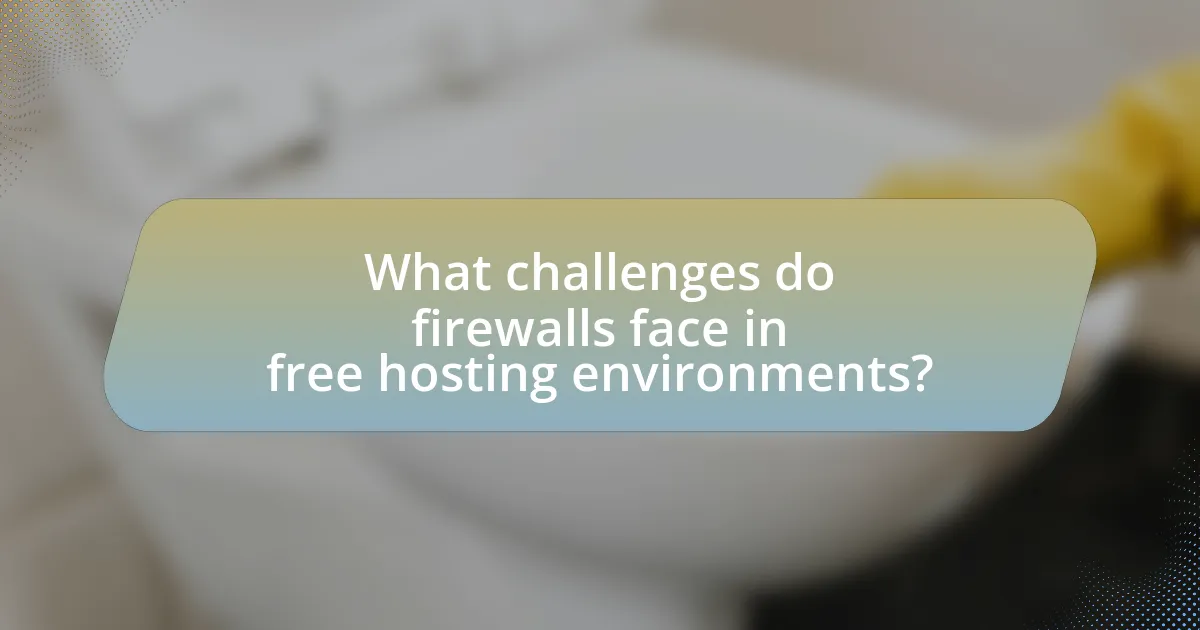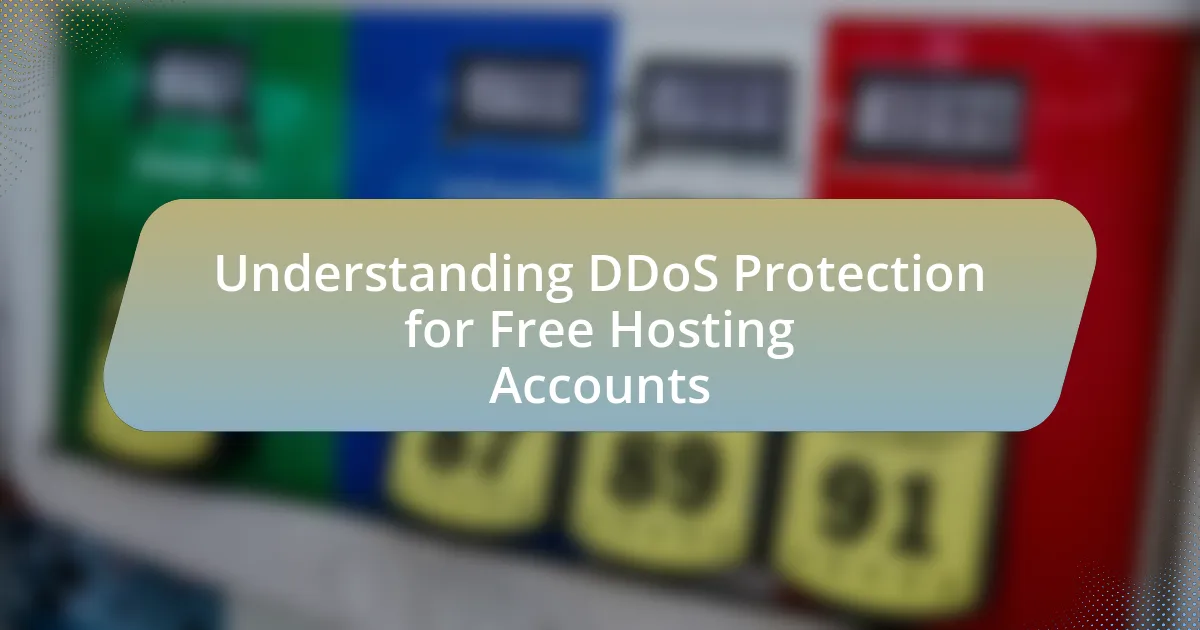Firewalls play a crucial role in free hosting environments by safeguarding servers and user data from unauthorized access and cyber threats. They function by filtering incoming and outgoing traffic based on established security rules, thereby preventing attacks such as Distributed Denial of Service (DDoS) and data breaches. Key components of firewalls, including packet filtering, stateful inspection, and intrusion detection systems, work together to enhance security. The article also explores the types of firewalls commonly used, such as software and cloud-based firewalls, and discusses the challenges they face in resource-limited environments. Additionally, it highlights best practices for firewall management to optimize performance and mitigate risks associated with free hosting services.

What is the role of firewalls in free hosting environments?
Firewalls in free hosting environments serve to protect servers and user data from unauthorized access and cyber threats. They act as a barrier between trusted internal networks and untrusted external networks, filtering incoming and outgoing traffic based on predetermined security rules. In free hosting, where resources are often shared among multiple users, firewalls are crucial for preventing attacks such as Distributed Denial of Service (DDoS) and unauthorized data breaches, which can compromise the integrity of the hosting service. Their implementation helps maintain a secure environment, ensuring that users can operate their websites without significant risk of exposure to malicious activities.
How do firewalls function within free hosting environments?
Firewalls in free hosting environments function by monitoring and controlling incoming and outgoing network traffic based on predetermined security rules. These firewalls act as a barrier between trusted internal networks and untrusted external networks, ensuring that only legitimate traffic is allowed while blocking potentially harmful data packets. In free hosting, where resources are limited and security risks are heightened due to shared environments, firewalls help mitigate threats such as unauthorized access, data breaches, and denial-of-service attacks. Their effectiveness is supported by the implementation of both hardware and software firewalls, which can filter traffic at various levels, thus enhancing the overall security posture of free hosting services.
What are the key components of a firewall in this context?
The key components of a firewall in the context of free hosting environments include packet filtering, stateful inspection, proxy services, and intrusion detection systems. Packet filtering allows the firewall to examine data packets and determine whether to allow or block them based on predefined rules. Stateful inspection enhances security by tracking the state of active connections and making decisions based on the context of the traffic. Proxy services act as intermediaries between users and the internet, providing an additional layer of security by masking the user’s IP address. Intrusion detection systems monitor network traffic for suspicious activity and potential threats, alerting administrators to possible breaches. These components work together to protect free hosting environments from unauthorized access and cyber threats.
How do these components interact to provide security?
Firewalls interact with other security components, such as intrusion detection systems (IDS) and antivirus software, to create a multi-layered defense mechanism that enhances overall security. Firewalls monitor and control incoming and outgoing network traffic based on predetermined security rules, effectively blocking unauthorized access while allowing legitimate traffic. Intrusion detection systems complement firewalls by identifying and alerting on suspicious activities that may bypass firewall protections, thereby providing an additional layer of scrutiny. Antivirus software scans for and removes malicious software that could exploit vulnerabilities in the system, further securing the environment. Together, these components form a cohesive security architecture that mitigates risks and protects sensitive data in free hosting environments.
Why are firewalls essential for free hosting environments?
Firewalls are essential for free hosting environments because they provide a critical layer of security that protects against unauthorized access and cyber threats. In free hosting scenarios, where resources are shared among multiple users, the risk of attacks such as DDoS, malware, and data breaches increases significantly. Firewalls help mitigate these risks by monitoring incoming and outgoing traffic, blocking malicious requests, and enforcing security policies. According to a report by Cybersecurity Ventures, cybercrime is projected to cost the world $10.5 trillion annually by 2025, highlighting the importance of robust security measures like firewalls in safeguarding vulnerable hosting environments.
What specific threats do firewalls protect against?
Firewalls protect against specific threats such as unauthorized access, malware, and denial-of-service (DoS) attacks. Unauthorized access occurs when malicious actors attempt to infiltrate a network to steal data or disrupt services; firewalls monitor and filter incoming and outgoing traffic to block these attempts. Malware, including viruses and ransomware, is often delivered through network connections; firewalls can detect and prevent these harmful programs from entering a system. Denial-of-service attacks aim to overwhelm a network with traffic, rendering it unusable; firewalls can identify and mitigate such traffic surges to maintain service availability.
How do firewalls enhance user trust in free hosting services?
Firewalls enhance user trust in free hosting services by providing a critical layer of security that protects user data from unauthorized access and cyber threats. This security measure reassures users that their information is safeguarded against potential breaches, which is particularly important in free hosting environments where resources may be limited. According to a study by the Ponemon Institute, 70% of consumers are more likely to trust a service that employs robust security measures, including firewalls. This trust is essential for user retention and satisfaction, as it directly impacts users’ willingness to share sensitive information and engage with the service.

What types of firewalls are commonly used in free hosting environments?
Commonly used firewalls in free hosting environments include software firewalls and cloud-based firewalls. Software firewalls, such as iptables or UFW, are often implemented on the server level to control incoming and outgoing traffic based on predefined security rules. Cloud-based firewalls, like those offered by providers such as Cloudflare, provide an additional layer of security by filtering traffic before it reaches the hosting server. These types of firewalls are essential for protecting free hosting services from various cyber threats, ensuring that resources are safeguarded while maintaining accessibility for users.
How do hardware firewalls differ from software firewalls in this context?
Hardware firewalls are physical devices that provide network security by filtering traffic at the perimeter of a network, while software firewalls are applications installed on individual devices to monitor and control incoming and outgoing traffic. In the context of free hosting environments, hardware firewalls typically offer centralized protection for multiple users and can handle higher traffic loads, making them suitable for shared resources. Conversely, software firewalls provide customizable security settings for individual users but may be less effective in managing large-scale threats that affect the entire hosting environment. This distinction is crucial as it impacts the overall security posture and resource allocation in free hosting scenarios.
What are the advantages of using hardware firewalls?
Hardware firewalls provide robust security by acting as a barrier between internal networks and external threats. They offer advantages such as enhanced performance, as they handle traffic processing independently from the host system, reducing the load on servers. Additionally, hardware firewalls typically include advanced features like intrusion detection and prevention systems, which actively monitor and respond to potential threats. Their dedicated nature allows for better scalability, accommodating increased traffic without compromising security. Furthermore, hardware firewalls often provide a higher level of security through physical separation from the network, making it more difficult for attackers to bypass defenses.
What are the limitations of software firewalls in free hosting?
Software firewalls in free hosting have several limitations, primarily due to resource constraints and lack of advanced features. These firewalls often operate with limited processing power and memory, which can hinder their ability to effectively monitor and filter traffic. Additionally, free hosting services may not provide regular updates or support for the firewall software, leaving vulnerabilities unaddressed. Furthermore, software firewalls typically lack the comprehensive security features found in hardware firewalls, such as intrusion detection systems and advanced threat protection, making them less effective against sophisticated attacks.
What role do cloud-based firewalls play in free hosting environments?
Cloud-based firewalls serve as essential security measures in free hosting environments by providing protection against various cyber threats. These firewalls monitor and filter incoming and outgoing traffic, ensuring that malicious activities such as DDoS attacks, unauthorized access, and data breaches are mitigated. In free hosting scenarios, where resources are limited and security may not be prioritized, cloud-based firewalls offer scalable and cost-effective solutions that can adapt to fluctuating traffic demands. Their deployment can significantly enhance the overall security posture of free hosting services, as evidenced by studies showing that organizations utilizing cloud-based firewalls experience a reduction in security incidents by up to 50%.
How do cloud-based firewalls improve scalability and flexibility?
Cloud-based firewalls enhance scalability and flexibility by allowing organizations to easily adjust their security resources in response to changing demands. These firewalls operate on a distributed architecture, enabling rapid deployment and scaling without the need for physical hardware upgrades. For instance, businesses can increase or decrease their firewall capacity based on traffic fluctuations, ensuring optimal performance during peak times. Additionally, cloud-based firewalls support various configurations and policies that can be modified in real-time, allowing for quick adaptation to new threats or compliance requirements. This adaptability is crucial in dynamic environments, where traditional firewalls may struggle to keep pace with evolving needs.
What are the security implications of using cloud-based firewalls?
Cloud-based firewalls can introduce several security implications, including potential data exposure, reliance on third-party security measures, and challenges in compliance with regulations. The use of cloud-based firewalls means that sensitive data may traverse the internet, increasing the risk of interception by malicious actors. Additionally, organizations depend on the cloud service provider’s security protocols, which may not align with their specific security needs or standards. Furthermore, compliance with regulations such as GDPR or HIPAA can be complicated, as data may be stored or processed in jurisdictions with varying legal protections. These factors highlight the need for careful evaluation of cloud-based firewall solutions to ensure they meet an organization’s security requirements.

What challenges do firewalls face in free hosting environments?
Firewalls in free hosting environments face significant challenges, primarily due to limited resources and lack of control over the hosting infrastructure. These environments often have restricted bandwidth and processing power, which can hinder the firewall’s ability to effectively monitor and filter traffic. Additionally, the shared nature of free hosting services increases vulnerability to attacks, as multiple users may inadvertently expose the system to threats. Furthermore, the absence of dedicated support and maintenance in free hosting can lead to outdated firewall configurations, making them less effective against evolving security threats.
How do resource limitations affect firewall effectiveness?
Resource limitations significantly reduce firewall effectiveness by restricting processing power, memory, and bandwidth available for traffic analysis and filtering. When firewalls operate under constrained resources, they may struggle to inspect all incoming and outgoing traffic thoroughly, leading to potential vulnerabilities. For instance, a study by the SANS Institute highlights that firewalls with limited CPU capacity can drop packets or fail to apply security policies effectively, increasing the risk of unauthorized access or malware infiltration. Additionally, insufficient memory can result in the inability to maintain comprehensive logs or handle concurrent connections, further compromising security measures.
What strategies can be employed to optimize firewall performance?
To optimize firewall performance, implementing strategies such as load balancing, rule optimization, and hardware upgrades is essential. Load balancing distributes traffic across multiple firewalls, preventing any single device from becoming a bottleneck, which enhances overall throughput. Rule optimization involves simplifying and consolidating firewall rules to reduce processing time; studies show that a well-structured rule set can improve performance by up to 50%. Additionally, upgrading hardware, including using faster processors and more memory, directly impacts the firewall’s ability to handle high volumes of traffic efficiently. These strategies collectively ensure that firewalls operate at peak performance, especially in free hosting environments where resource constraints are common.
How can users mitigate risks associated with free hosting services?
Users can mitigate risks associated with free hosting services by implementing robust security measures, including the use of firewalls. Firewalls act as a barrier between the user’s website and potential threats, filtering incoming and outgoing traffic based on predetermined security rules. According to a study by the National Institute of Standards and Technology, firewalls can significantly reduce the risk of unauthorized access and data breaches, which are common vulnerabilities in free hosting environments. Additionally, users should regularly update their software and monitor their website for unusual activity to further enhance security.
What best practices should be followed for firewall management in free hosting?
Best practices for firewall management in free hosting include regularly updating firewall rules, monitoring traffic for unusual patterns, and implementing strict access controls. Regular updates ensure that the firewall can defend against the latest threats, as cyber threats evolve rapidly. Monitoring traffic helps identify potential breaches or attacks, allowing for timely responses. Strict access controls limit who can access the hosting environment, reducing the risk of unauthorized access. According to a report by the Cybersecurity & Infrastructure Security Agency, organizations that implement these practices significantly reduce their vulnerability to attacks.
How often should firewall rules be updated and reviewed?
Firewall rules should be updated and reviewed at least quarterly. Regular updates are essential to adapt to evolving security threats and changes in network architecture. According to the SANS Institute, organizations that review their firewall rules quarterly are better positioned to mitigate risks associated with outdated configurations and vulnerabilities. Additionally, any significant changes in the network, such as new applications or services, should prompt an immediate review of firewall rules to ensure they remain effective and aligned with security policies.
What common mistakes should be avoided in firewall configuration?
Common mistakes to avoid in firewall configuration include overly permissive rules, neglecting to update firewall policies, and failing to log and monitor traffic. Overly permissive rules can expose systems to unnecessary risks by allowing too much traffic, while outdated policies may not address current threats, leaving vulnerabilities. Additionally, not logging and monitoring traffic can prevent administrators from detecting and responding to potential security incidents effectively. These mistakes can significantly compromise the security posture of a network, especially in free hosting environments where resources may be limited.





